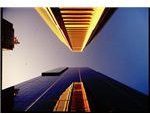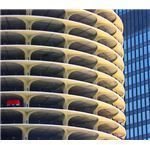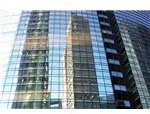Tips on How to Take Pictures of Cities
How to take better night photographs of cities
Tips on How to Take Pictures of Cities
Architectural Photography
- In short, it is shooting buildings and structures - whether modern or ancient. And there is a lot of way you can add life to these otherwise lifeless monuments. I always prefer shooting ancient monuments in context of its surrounding environment, whereas modern structures tend to look good even in isolation.
- Try to get a deep azure sky on the backdrop of a
(usually brown) ancient monument. This can be done by using a very fast
shutter speed and a narrow aperture. This photo here courtesy pwbaker makes the point.

- A wide-angle lens will immensely help shooting cityscapes. You can get a larger part of the city in front of you on your image, while avoiding the 'flattening' often introduced in telephoto lenses. The depth offered at a wide angle is always superior to a normal 35mm or a zoomed-in shot.
- That said, don't be afraid to zoom in and fill the viewfinder with your subject. Just take care to include leading lines into the composition. Boring urban architecture gets a wholly different viewpoint when zoomed in on.
- If
you're shooting an oft-photographed monument, say the Eiffel Tower or
the Taj Mahal, hunt out for unique and different angles. You may also
try shooting from the side or from behind a monument, to capture the
'other side'. This photograph, courtesy mugley, is a case in point.

- Play around with shapes and textures. Zoom in close to capture the texture of a building, or use wider focal lengths to capture shape. A variation of this theme would be silhouettes. You really don't need to wait till evening to get good silhouettes. You can shoot them in bright daylight too, by shooting against the sun and keeping a very fast shutter speed.
- Try to bring in Contrast.
In terms of color, buildings, materials, shape....you get the general
idea. It makes for very interesting shots. This picture by O Palsson brings in two contrasting elements - the round shape of the first building with the straight lines on the adjacent one.

- Its always good to know the 'sunny f/16' rule. Unless you have a tripod to eliminate shake, the best shutter speed to give you a well exposed image is the inverse of your ISO when you set your aperture to f/16.
- Another area to watch out for is reflections. It may be from water bodies, glass,
metal or any other glossy surface. Depending on how you use it,
reflections can make or break a photo. Here's an example of how
reflection has been very smartly used. Photo courtesy: OiMax

Urban & City Photography: 70 Dramatic Examples
Joel Bankhead on Nov 23rd 2010Cities are truly amazing places. The dramatic collision of people and architecture gives each city a unique essence and existence. They are living breathing places that are simultaneously busy, lonely, awake, tired, and alive.
By their very nature, cities provide a varied and fascinating photography subject and today we’ll be looking at some excellent examples of urban photography to get you excited about shooting your city. Before we get stuck in we’ll look briefly at some tips to help you take urban shots that make an impact.
more
Comments
Post a Comment